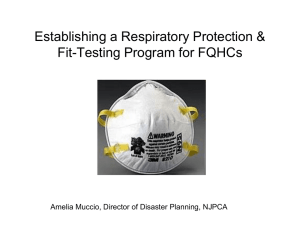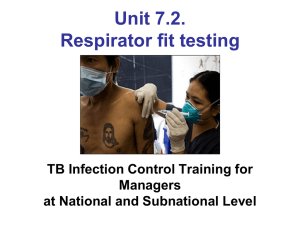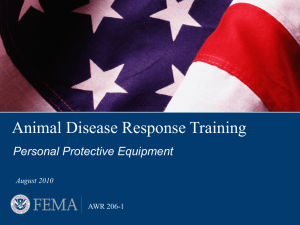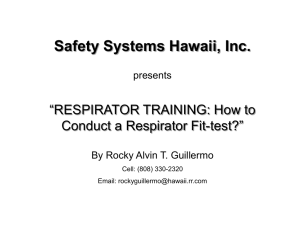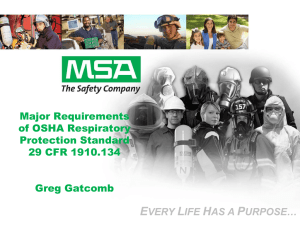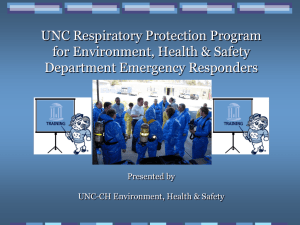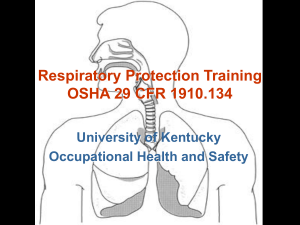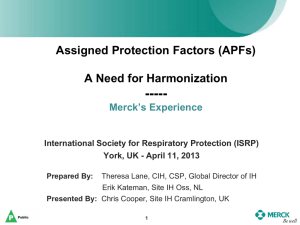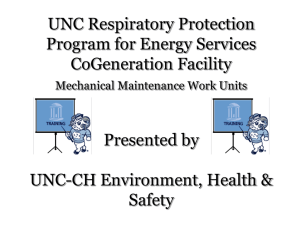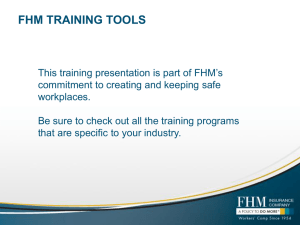Respiratory Protection Training
advertisement
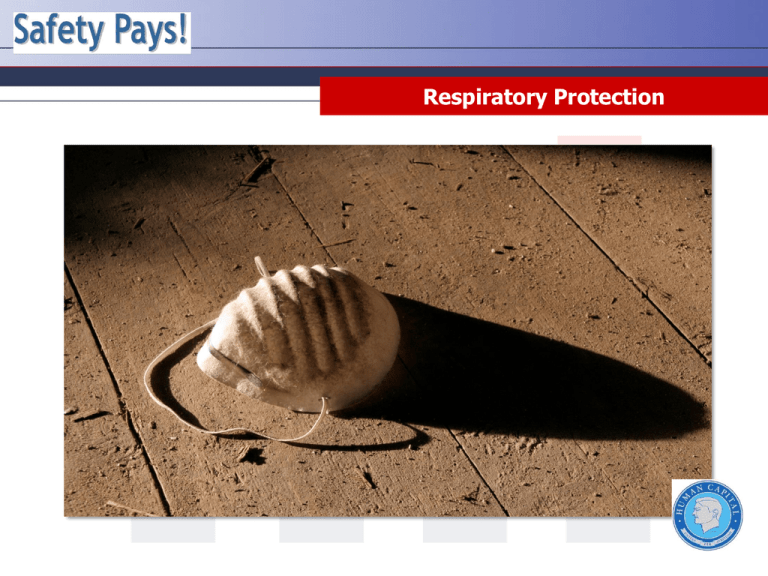
Respiratory Protection Disclaimer • This training material presents very important information. • Your organization must do an evaluation of all exposures, applicable codes and regulations, and establish proper controls, training, and protective measures to effectively control exposures and assure compliance. • This program is neither a determination that the conditions and practices of your organization are safe nor a warranty that reliance upon this program will prevent accidents and losses or satisfy local, state or federal regulations. • All procedures and training, whether required by law or not, should be implemented and reviewed by safety and risk management professionals, and legal counsel to ensure that all local, state and federal requirements are satisfied. Course Outline – Respiratory Protection 1. Why Take Respiratory Protection Training? 2. When to Use Respirators? 3. Types of Respirators 4. Filter and Cartridges 5. Atmosphere Supplying Respirators 6. Fit Testing 7. Respirator Use 8. Protection Factors 9. Respirator Program 10. Summary Why Take Respiratory Protection Training? Respirators protect employee health: • Employees wear respirators to protect themselves against the inhalation of harmful air contaminants in the work place. • Respirators are the last line of defense against airborne contaminants. • Where possible, engineering, administrative and work practice controls must be used to control or eliminate hazards and minimize employee exposures. Why Take Respiratory Protection Training? Respirators are only effective: • If the employees know the correct respirator to use for a given situation. • If the respirators are available when employees need to use them. • If employees know how to use them. • If the respirator fits well and has an adequate face to face piece seal (tight fitting respirators) • If employees properly maintain them and store them per the manufacturer’s specifications. When To Use Respirators? Respirators must be worn: • Where feasible engineering controls do not adequately remove or control the hazards. Respiratory protection will be used to provide employees with proper protection against those hazards. • Respiratory protection may also be used while engineering controls are being evaluated or implemented. Types of Respirators Respirator type depends on the job and hazard type: • There are many different types of respirators.. • Only approved respirators can be considered. They must be approved for protection against the specific hazards that are present in the work site. • Respirators are tested and approved by the National Institute for Occupational Safety and Health (NIOSH) or the Mine Safety and Health Administration (MSHA). • The entire respirator assembly, including cartridges, filters, and hoses must pass certification tests in order to be approved. Types of Respirators Filtering face piece (dust mask): • A negative pressure particulate respirator, with a filter as an integral part of the face piece or with the entire face piece composed of the filtering medium. General Respirator Categories Negative pressure respirator: • A respirator where the air pressure inside the face piece is negative during inhalation with respect to the ambient air pressure outside the respirator. General Respirator Categories Positive pressure respirator: • A respirator in which the pressure inside the respiratory inlet covering exceeds the ambient air pressure outside the respirator. General Respirator Categories Loose-fitting respirators: Hood Helmet Loose-Fitting Face piece • These do not require a fit test, or the user to be clean shaven. • They do require an external air source and minimum air flow maintained. Types of Respirators Air-purifying respirators (APR): Half mask Full face piece Air-purifying respirators seal against the wearer’s face and require fit testing to verify that it is adequately protecting the user. These devices: •Provide protection against specific contaminants. •Provide a specific level of protection against exposure. •Provide clean or filtered air to the user’s breathing zone. Types of Respirators Air purifying respirators-APR: • Air purifying respirators are stand alone, as opposed to air supplying respirators that are attached to a supplied air source. • Air purifying respirators (APRs) use a filter (cartridge or canister) to remove specific contaminants from the air. Contaminants come in either a particulate or chemical form. Types of Respirators Air purifying respirators-APR (continued): • Respirator filters must match the respirator brand since they are approved as a unit. • Particulate respirator filters have efficiency ratings: - “95” means 95% filtering efficiency - “99” means 99% filtering efficiency - “100” means 99.97% filtering efficiency Types of Respirators Don’t use air purifying respirators in these conditions: • Whenever there are unidentified contaminants or when contaminant concentrations are unknown. • If contaminant concentrations exceed maximum use concentrations. • If gases or vapors have poor warning properties. • In the case of high relative humidity. • Oxygen deficient: An atmosphere with an oxygen content below 19.5% by volume. Note: Air naturally contains 20.9% Oxygen. • Immediately Dangerous to Life and Health (IDLH): An atmosphere that poses an immediate threat to life, would cause irreversible adverse health effects, or would impair an individual’s ability to escape from a dangerous atmosphere. Types of Respirators Powered air-purifying respirator (PAPR): • Use a blower to force the ambient air through air-purifying elements to the inlet covering. • Are considered to be positive pressure under most operating conditions. • However, they can be over breathed, potentially making them negatively pressurized for a brief period of time. Types of Respirators Escape-only respirator: • Emergency escape respirators are intended to be used only during an emergency to evacuate an area where an unplanned airborne contaminant is present. • They are not intended to be used on a routine basis. • They do not require employees to be fit tested. Types of Respirators Atmosphere – supplying respirators: These supply the user with breathing air from a source independent of the ambient atmosphere. Two types: • • Supplied-air respirators (SARs) Self-contained breathing apparatus (SCBA) Operating elements: • • • Continuous Flow: Provides a continuous flow of breathing air to the respiratory inlet covering. Demand: Admits breathing air to the face piece only when a negative pressure is created inside the face piece by inhalation. Pressure Demand: Admits breathing air to the face piece when the positive pressure inside the face-piece is reduced by inhalation. Atmosphere - Supplying Respirators Atmosphere – supplying respirators (continued): Typical system components: • • • • • Compressor or Cylinder(s) Air delivery lines Air purification system Reserve air supply Carbon monoxide filter or alarm for (oil lubricated compressors) Air is supplied through a hose to the worker’s face piece. Atmosphere – Supplying Respirators Supplied Air Respirator (SAR): • An atmosphere-supplying respirator for which the source of breathing air is not designed to be carried by the user. • Also called airline respirator, supplied air respirators deliver clean breathing air from outside the work area. • Also used in IDLH environments and emergency response situations. Atmosphere – Supplying Respirators Self-contained breathing apparatus (SCBA): • An atmosphere-supplying respirator for which the breathing air source is designed to be carried by the user. • Supplied Air Respirators require Grade D as the minimum quality air used in supplied air respirator systems in fire fighting, general industry, and hazmat projects. Atmosphere – Supplying Respirators Self-contained breathing apparatus (SCBA) (continued): Grade D Breathing Air Requirements: Carbon Monoxide (CO) < 10 parts per million Carbon Dioxide (CO2) < 1000 parts per million Condensed Hydrocarbons < 5 milligrams per cubic meter Noticeable Odors None The Compressed Gas Association (CGA) standard does not specifically establish a limit for moisture; however, a limit of 66 parts per million is necessary to assure proper function of CO scrubbing devices. Filters and Cartridges Particulate air filters: • High efficiency particulate air filters also known as HEPA filters are at least 99.97% efficient in removing particles that are 0.3 micrometers in diameter and larger. Filters and Cartridges Particulate air filters (continued): • 95% of all respirators are typically single use disposable respirators. • HEPA filters are referenced in the standards as N100, R100, or P100. • N, R, and P are filter performance designations when in contact with oil. - “N” means NOT recommended for oil mist. - “R” means oil mist RESISTANT (one-time use). - “P” means oil PROOF (reusable) Filters and Cartridges Canister and filter cartridges: • A container with a filter, sorbent, or catalyst, or combination of these items. • Removes specific contaminants from the air passed through the container. • Many respirator cartridges combine a filter layer with a chemical sorbent layer. • These types of canisters are typically referred to as “stack” filters. Filters and Cartridges Canister and filter cartridges: • Must be labeled and color coded with the NIOSH approval label. • The label must not be removed and must remain legible. • The “TC number” is no longer designated on cartridges or filters. Filters and Cartridges Service life: • The period of time that a respirator, filter or sorbent, or other respiratory equipment provides adequate protection to the wearer is referred to as it’s service life. • Particulate filters are typically good until breathing becomes restricted. • Sorbent materials have several different options for determining useful life. Factors for evaluation of service life include: – Chemical Warning Properties – Chemical Concentrations – Identity of the Chemical – Temperature and Humidity Filters and Cartridges Change-out schedules: • OSHA requires end-of-service life indicators (ESLI) for organic vapor and chemical cartridges. When no ESLI is available, a cartridge change-out schedule must be established and implemented. • Chemical cartridges tend to become saturated and no longer effective, thus break-through can occur, exposing the respirator user. Where applicable, cartridge change-out schedules will be established. • Change-out schedules developed using mathematical models, manufacturer's software, calculations, rules of thumb. Respirator Fit Test Respirator fit: • Proper respirator fit depends on the face to face piece seal. • This can be effected by: – Overall Fit (size and shape of respirator) – Facial hair – Facial scars – Eye glass temple bars Respirator Fit Test Fit testing: • Prior to fit testing, the subject must be medically approved to wear a respirator. • Before an employee uses any respirator with a negative or positive pressure tight-fitting face piece, the employee must be fit tested with the same make, model, style, and size of respirator that will be used. Respirator Fit Test Fit testing (continued): • Employees using tight-fitting face piece respirators must pass an appropriate fit test: There are two types of respirator fit testing: • Qualitative • Quantitative • Fit tests must be passed: – Prior to initial use – Whenever a different respirator face piece (size, style, model or make) is used – At least annually thereafter – Change in facial features that could affect seal. Respirator Fit Test Qualitative fit testing (QLFT): • It is a pass/fail method of testing the respirator-face seal. This is a subjective test in which a test agent is presented and the subject is asked while performing exercises whether they can sense the test agent. • The OSHA regulations allow qualitative tests only for respirator use in atmospheres where airborne contaminant levels are no more than 10 times the PEL. • The following methods are allowed by OSHA: – Irritant smoke – Isoamyl acetate (banana oil) – Saccharine Mist – Bitrex Respirator Fit Test Quantitative fit test (QNFT): • This is a more sophisticated method of determining the fit of a respirator. This method is used to measure how well a particular respirator fits an individual. • An instrument is used to make an assessment of the adequacy of the respirator fit, by numerically measuring the amount of leakage into the respirator. • The results of these tests are reflected numerically and are called fit factors. Use of Respirators Why use a respirator? • Respirators must be selected and used in accordance with a written Hazard Assessment. • Respirators must be inspected before each use. • Inspect your respirator for the following: – Intact and functional straps – No cracks in the face piece – Proper cartridge assembly – Intact, clean and functioning valves – Proper assembly of all parts – Cleanliness – Pliability of the face piece Use of Respirators Seal checks: 1. Positive pressure check: • Cover the exhalation valve with the palm of your hand. • Lightly exhale to create pressure in the mask. • Check for leaks (air flowing out of the mask). Positive pressure check Respirator wearers must perform two types of user seal checks each time the respirator is put on. Use of Respirators Seal checks (continued): 2. Negative pressure check: • Cover the cartridge intakes typically with the palm(s) • Lightly inhale until the face piece begins to collapse toward the face • Check for leaks (air flowing into the mask) Negative Pressure Check If any leaks are detected, adjust the mask and try again, if leaks continue, do not use! Use of Respirators Respirators cannot be used in these cases: • While using tobacco products. • While using chewing gum. • While eating or drinking. • When facial hair such as beards or mustaches interfere with the seal. Use of Respirators Employees must leave the respirator use area: • In the event that they need to wash their face and respirator face piece. • If they detect contaminants, changes in breathing resistance, or leakage of the face piece. • To replace the respirator or filter, cartridge, or canister. Use of Respirators Cleaning of a respirator: It is necessary to clean the respirator between uses. Upon removing tight-fitting respirators: • Remove and discard cartridges, if appropriate. • Wash hands and face thoroughly. • Disassemble the respirator and wash all parts thoroughly with soap and warm water. • Re-assemble and store the respirator properly. Use of Respirators Cleaning of a respirator (continued): • Respirators need to be cleaned before they are placed into storage between usage. • Precautions must be taken to prevent the contamination of the storage container. This may include covering or removal of filters. • Reusable respirators must be stored, when not in use, in a sealed container and in a clean and dry location that is located away from chemical use or storage areas. Use of Respirators Maintenance of a respirator: • Replace worn/deteriorated parts as needed. • Only use parts and cartridges approved for your brand and type of respirator. • Parts and cartridges are not interchangeable between brands and types. Use of Respirators Maintenance of a respirator (continued): • Maintain appropriate surveillance of work area conditions and degree of exposure or stress. • Re-evaluate the respirator’s effectiveness when it may be affected by changes in work area or exposure. • If you detect contaminant breakthrough, changes in breathing resistance, or leakage of the face piece, the respirator must be replaced or repaired before returning to the work area. • Also, leave the respirator area immediately if you experience dizziness, disorientation, or any other unusual symptom that could indicate possible exposure. Protection Factors Assigned protection factors (APFs): Numbers are assigned to the respirator which reflect the degree of protection offered by its style type. • APFs are assigned to generic respirator types by NIOSH. • APFs are used to determine the type of respirator needed to adequately protect workers under various exposure conditions. • The ”Protection Factor” is valid only if the wearer passes the appropriate type of fit test according to respirator type. Protection Factors Assigned protection factors: Half-mask, air-purifying, with appropriate cartridges: 10 Supplied-air, half-mask, operated in demand mode: 10 Powered air-purifying, loose-fitting hood or helmet: 25 Supplied-air, continuous flow, equipped with hood or helmet: 25 Air-purifying, full face piece, with appropriate cartridge: 50 Powered air-purifying, tight-fitting face piece, with appropriate cartridges: 50 Supplied-air, full face piece, operated in demand mode: 50 Protection Factors Assigned Protection Factors (continued): Supplied-air, tight fitting face piece, operated in continuous flow: 50 Self-contained breathing apparatus operated in demand mode: 50 Supplied-air, half-mask, operated in pressure demand: 1,000 Supplied-air, full face piece, operated in pressure demand: 2,000 Self-contained breathing apparatus, pressure demand mode: 10,000 Supplied-air respirator, full face piece, operated in pressure demand mode with an emergency egress bottle: 10,000 Protection Factors Maximum use concentration (MUC): • The maximum use concentration of a specific contaminant for which a respirator may be used. • The MUC is calculated by multiplying the established exposure limit for a specific contaminant (such as an OSHA Permissible Exposure Limit or PEL) by the assigned protection factor of a respirator; or APF x PEL. • Example: The PEL for benzene is 1 ppm. Respirator Protection Factor Equation Maximum Use Concentration Half face 10 1 x 10 10 ppm Full face 50 1 x 50 50 ppm PAPR 100 1 x 100 1000 ppm (IDLH) Respirator Program A respirator program consists of: • A written program with worksite-specific procedures is required when respirators are necessary or required by the employer. • A written program is NOT required if the only respirators that are used are filtering face piece respirators (dust masks) on a voluntary basis. • The program must be kept up to date to reflect changes in workplace conditions that affect respirator use. • The program must designate a program administrator who is qualified by appropriate training or experience to administer or oversee the program and conduct the required program evaluations. • Respirators, training, and medical evaluations must be provided at no cost to the employee as required. Respirator Program Voluntary respirator use: • When only filtering face piece respirators (dust masks) are allowed to be used strictly on a voluntary basis, medical evaluations, fit testing and a written program are not required. However, all employees who voluntarily use dust masks are required to receive Appendix D of the respirator standard either verbally or in written form. • If respirators other than filtering face piece types are used on a voluntary basis, appropriate elements of a written program are required to be implemented (medical approval, fit testing and Appendix D). Respirator Program The elements of a respirator program: The respiratory protection program for “required use” and “tight-fitting” respirators must include and address procedures for: • Program administration • Written program availability for each respirator user • Hazard assessments • Proper respirator selection • Standard operating procedures (respirator use) • Employee training • Medical evaluations and fit testing • Program evaluation and record keeping Respirator Program Medical evaluations: • Medical evaluations must be provided to determine the wearer’s ability to use a respirator, before fit testing and use. • Respirator usage places an additional strain on the heart, lungs, and temperature control of employees. • A physician or other licensed healthcare professional (PLHCP) needs to perform medical evaluations using a medical questionnaire or an initial medical examination that obtains the same information. Respirator Program Medical evaluations: • The medical review of the questionnaire could result in one of the following: – Approval for all respirator use – Approval for limited respirator use – Recommendation for a particular type of respirator use (e.g., PAPR) – Request for further medical evaluation (physical exam) – NO approval for respirator use Respirator Program Selection of respirators: • An appropriate respirator must be selected and provided based on the respiratory hazards to which the worker is exposed considering all user factors that affect respirator performance and reliability. Remember, air-purifying respirators do not provide oxygen! • Select respirators from a sufficient number of models and sizes so that the respirator is acceptable to, and correctly fits, the user. Respirator Program Selection of respirators (continued): • Select a NIOSH-certified respirator that shall be used in compliance with the conditions of its certification. • Identify and evaluate the respiratory hazards in the workplace, including worker exposures and identification of the contaminant’s chemical state & physical form. • Where exposure cannot be identified or reasonably estimated, the atmosphere shall be considered IDLH. Respirator Program Program evaluation: • Evaluations of the workplace must be conducted as necessary (at least annually is required) to ensure the effective implementation of the program. • Employees that are required to use respirators need to be consulted to assess their views on the program effectiveness and to identify and correct any problems. Respirator Program Program evaluation (continued): • Records of medical evaluations must be retained and made available for the duration of employment plus 30 years. • A record of fit tests must be established and retained until the next fit test is administered. • A written copy of the current program must be retained. • Written materials required to be retained must be made available upon request to affected employees and OSHA. • Medical records must be maintained for 30 years beyond the last date of employment. Summary Summary: • • Respirators are an important element in protecting workers from airborne hazards. Engineering and work practice controls must be evaluated to determine if they can reduce employee exposures before placing an employee in a respirator. Summary Summary (continued): • Various respirator types are available for specific contaminants and differing work environments. • Before an employee can be assigned a respirator they need to be evaluated to determine if they are medically able to wear the respirator safely. • Employees need to be fit tested to assure that the respirator fits them properly. • Training for the care, use, and limitations must be provided based on the respirator type and the hazards associated with the usage of the respirator. Respiratory Protection This form documents that the training specified above was presented to the listed participants. By signing below, each participant acknowledges receiving this training. Organization: Trainer: Trainer’s Signature: Class Participants: Name: Signature: Date: Name: Signature: Date: Name: Signature: Date: Name: Signature: Date: Name: Signature: Date: Name: Signature: Date: Name: Signature: Date: Name: Signature: Date: Name: Signature: Date: Name: Signature: Date: Name: Signature: Date: Name: Signature: Date:
